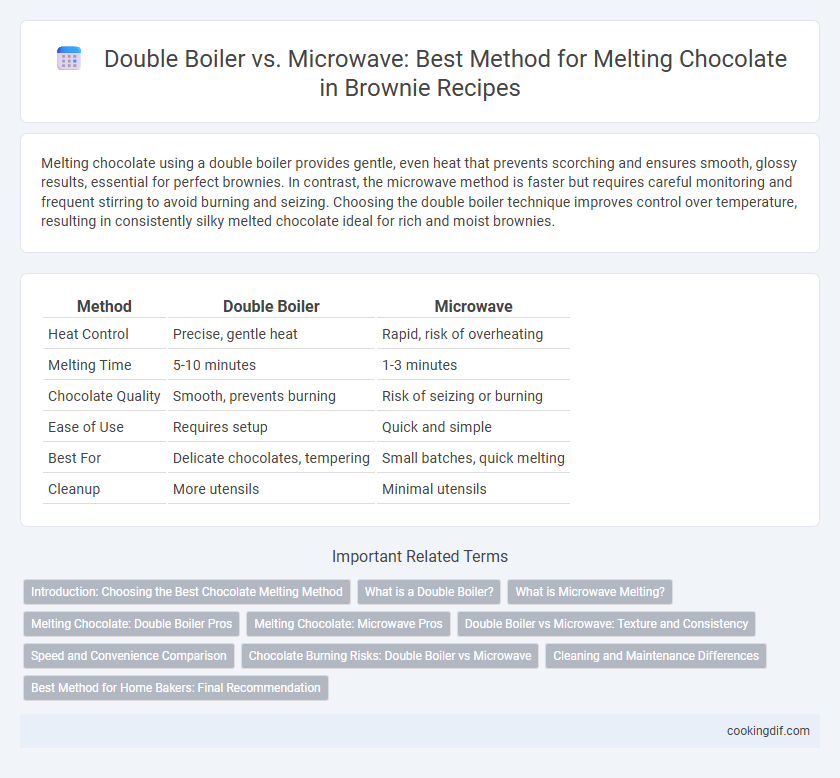Melting chocolate using a double boiler provides gentle, even heat that prevents scorching and ensures smooth, glossy results, essential for perfect brownies. In contrast, the microwave method is faster but requires careful monitoring and frequent stirring to avoid burning and seizing. Choosing the double boiler technique improves control over temperature, resulting in consistently silky melted chocolate ideal for rich and moist brownies.
Table of Comparison
| Method | Double Boiler | Microwave |
|---|---|---|
| Heat Control | Precise, gentle heat | Rapid, risk of overheating |
| Melting Time | 5-10 minutes | 1-3 minutes |
| Chocolate Quality | Smooth, prevents burning | Risk of seizing or burning |
| Ease of Use | Requires setup | Quick and simple |
| Best For | Delicate chocolates, tempering | Small batches, quick melting |
| Cleanup | More utensils | Minimal utensils |
Introduction: Choosing the Best Chocolate Melting Method
Melting chocolate for brownies requires precise temperature control to prevent burning and achieve smooth texture. A double boiler offers gentle, even heat by using steam, preserving chocolate's glossy finish and rich flavor. Microwaving is faster but risks uneven melting and scorching if not carefully monitored, making double boilers the preferred choice for consistent results.
What is a Double Boiler?
A double boiler is a kitchen tool designed to gently melt chocolate by using indirect heat, consisting of two stacked pots where the bottom pot holds simmering water while the top pot holds the chocolate. This method ensures precise temperature control, preventing chocolate from burning or seizing, which is crucial for achieving a smooth and glossy texture in brownies. Compared to a microwave, a double boiler provides consistent heat that preserves chocolate's flavor and quality during the melting process.
What is Microwave Melting?
Microwave melting involves heating chocolate in short intervals within a microwave oven, allowing controlled melting without burning. This method requires stirring every 15-20 seconds to ensure even heat distribution and smooth consistency ideal for brownies. Compared to double boiler melting, microwave melting is faster and more convenient but demands careful monitoring to prevent overheating.
Melting Chocolate: Double Boiler Pros
Using a double boiler for melting chocolate ensures gentle, indirect heat that prevents scorching and promotes smooth, even melting. This method preserves the chocolate's rich flavor and glossy texture, essential for perfect brownie batter. Controlled temperature reduces the risk of seizing, making the double boiler ideal for delicate chocolate melting tasks.
Melting Chocolate: Microwave Pros
Microwaving chocolate offers precise temperature control through short bursts, reducing the risk of overheating and burning. It provides rapid and even melting, ideal for small batches needed in brownie recipes. The convenience and quick cleanup make microwaves a preferred choice for efficient chocolate melting in home baking.
Double Boiler vs Microwave: Texture and Consistency
Using a double boiler for melting chocolate offers precise temperature control, resulting in a smooth, glossy texture and consistent melt ideal for brownies. Microwaving chocolate risks uneven heating and potential scorching, causing grainy texture and inconsistent consistency that can affect the final brownie quality. Double boilers maintain gradual heat, preserving the chocolate's silky properties essential for rich, velvety brownie batter.
Speed and Convenience Comparison
Melting chocolate for brownies is faster in a microwave, typically taking 30 to 60 seconds with frequent stirring to avoid burning. A double boiler offers more control over temperature, preventing scorching but requires more time, often 5 to 10 minutes, making it less convenient for quick baking. The microwave's speed suits quick recipes, while the double boiler is preferred for precise, low-heat melting.
Chocolate Burning Risks: Double Boiler vs Microwave
Using a double boiler significantly reduces chocolate burning risks by providing gentle, indirect heat, maintaining a consistent temperature below chocolate's melting point. In contrast, microwaving chocolate can cause uneven heating and hotspots, increasing the likelihood of scorching or seizing if not stirred frequently and heated in short intervals. Proper temperature control with a double boiler ensures smooth, glossy melted chocolate ideal for brownies, whereas microwaving requires careful monitoring to avoid burnt or grainy texture.
Cleaning and Maintenance Differences
Using a double boiler for melting chocolate reduces the risk of scorching but requires thorough cleaning of both pots and secure handling of hot water to prevent spills. Microwaves offer quick melting with minimal dishwashing, yet uneven heating may cause chocolate residue buildup inside, demanding careful interior wiping. Choosing between these methods depends on balancing ease of cleaning with the precision needed to maintain smooth, clump-free melted chocolate ideal for brownies.
Best Method for Home Bakers: Final Recommendation
Using a double boiler is the best method for home bakers to melt chocolate for brownies because it provides gentle, even heat that prevents scorching and ensures smooth texture. Microwaving is faster but risks overheating and burning the chocolate due to uneven heat distribution. For consistent results and superior taste in brownies, the controlled temperature of a double boiler is highly recommended.
Double boiler vs Microwave for chocolate melting Infographic

 cookingdif.com
cookingdif.com